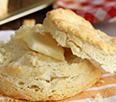February 2019 Farmhouse Kitchen
“What’s your favorite thing to cook?” I get the question all the time. And the answer is always biscuits. I often think there’s something tactile about working the dough that makes it therapeutic, but I imagine it’s more about the emotional connection to biscuits that makes them my favorite.
Making biscuits is an art. It’s something that has to be taught. I could write 100 recipes with incredible detail, and they would never be as helpful as someone who can stand with you and teach you the feel, the texture, the technique.
I was fortunate to have a host of amazing biscuit bakers in my family. From my mom to my grandparents to my great-grandmother, they all took time to show me the ways of expert biscuit making. And I think that in itself is the reason I love making biscuits so much. Each time I make them, I am reminded of sweet memories with each of them showing me their methods for perfect biscuits.
And while I can’t stand with you and show you all I’ve learned, I can at least share some of my most helpful hints and tips.
I’m a huge fan of generic and store brands when it comes to ingredients — most of the time. Flour isn’t one of them. In my house, White Lily is the only flour for making biscuits. It’s a soft winter wheat that’s lower in protein, which means light, fluffy, flaky biscuits. I love opting for self-rising flour to save a few steps.
My grandmother used lard as the fat in her biscuits, and my mom used vegetable shortening. I prefer butter. It adds an extra layer of flavor and makes your biscuits rise higher because the water in butter turns into steam. The other options are entirely fat and won’t create pockets of steam to give the biscuits lift like butter does.
While some folks say you want to work biscuit dough as little as possible, I reside in the other camp. Working the dough and folding it over on itself is vital to creating flaky layers, but your biscuit might sacrifice a little tenderness as a result. If you like soft, tender biscuits and don’t care much about the layers, you’ll want to work the dough as little as possible. If you like mile-high biscuits with tons of layers, just keep on folding it over. I usually fold mine over 8 to 10 times — and hardly ever use a rolling pin. I like to just pat it out with my hands. Yes, the heat from my hands might start melting the butter but not enough to make a huge difference.
One key to consistency with any type of baking is measuring the flour correctly. Don’t scoop a measuring cup into a canister of flour. That packs flour into the cup and will throw off your liquid-to-dry ratio. I always suggest you spoon the flour into a dry measuring cup and level it off with the back of a butter knife.
Remember, if the dough doesn’t turn out perfectly, you can always add more flour if it’s too sticky or more milk if it’s too dry. And never give up biscuit making after one try — or even a couple. I’ve made thousands of biscuits, and they don’t always turn out exactly the same. But the more you make them, the better you’ll get at knowing just what to add to get the dough where you need it to be.
And while biscuits are perfectly delicious on their own, I’ve shared a few favorite gravy recipes to make them even better. Y’all enjoy!

